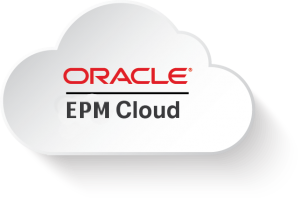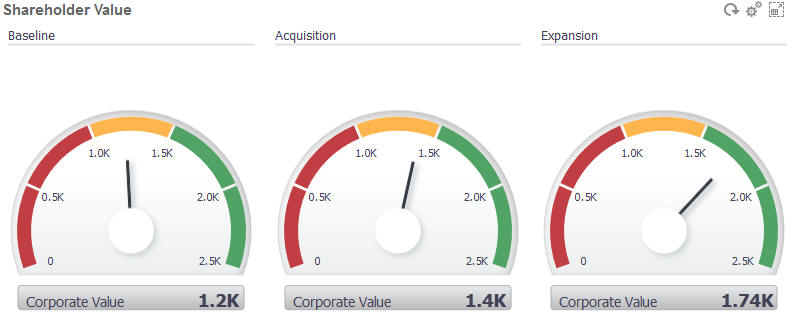Introduction
There are different architectural designs available to deploy Oracle EPM workloads in Oracle Cloud Infrastructure (OCI). This article will help you in choosing the right architecture for your Oracle EPM Instance using Security, Reliability and Redundancy features.
Types of Architectural designs:
- Deployment in a single availability domain (AD)
- Deployment across multiple ADs within a region
- Deployment across multiple regions
Required Products and Services:
- Oracle Enterprise Performance Management System
- Oracle Hyperion Financial Management
- Oracle Hyperion Planning
- Oracle Cloud Infrastructure Compute
- Oracle Cloud Infrastructure Database
- Oracle Cloud Infrastructure Networking
- Oracle Cloud Infrastructure Load Balancing
- Oracle Cloud Infrastructure FastConnect (Optional)
- Oracle Cloud Infrastructure Identity and Access Management
- Oracle Cloud Infrastructure Web Application Firewall
- Oracle Cloud Infrastructure Object Storage
- Oracle Cloud Infrastructure File Storage
- Oracle Cloud Infrastructure Block Volumes
Based on the requirement you can attach compute instances into Private Subnet (Or) Private & Public Subnets (Or) Public Subnet only.
Deployment in a single availability domain (AD)
In this architecture EPM Applications and databases are deployed across 2 fault domains and in a single AD as an Active – Active model topology.
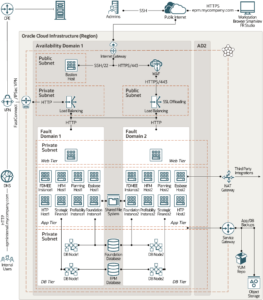
As the instances are hosted in the separate fault domains, A hardware failure or maintenance event does not affect both the instances at a time.
All applications and database tier components are attached to the private subnet to isolate them from unauthorized network access.
Both application tiers access the Shared File Storage for binaries and data generated by Hyperion applications. Also Fault tolerance is offered at the domain level.
Two nodes in the RAC database are placed in the separate fault domain for fault tolerance.
Deployment across multiple ADs within a region
In this architecture EPM Applications and databases are deployed across 2 Availability Domains and in a single Region as an Active – Passive (Symmetric) model topology.
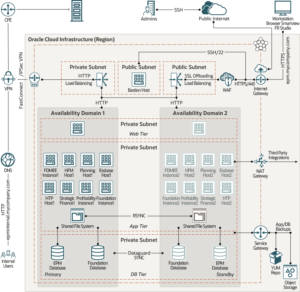
The web tier, application tier and database tier in an AD is designated as an Active environment & the same services in the other AD is designated as Passive/Standby environment. The load balancer routes the traffic to one environment at a time, In case of faults in the active environment the load balancer has to be updated with the stand by values .
Use the same logical hostnames for database and application tiers to reduce the effort of reconfiguring the instances during the switch over and switch back.
All applications and database tier components are attached to the private subnet to isolate them from unauthorized network access.
Application tier components have access to the Shared File Storage for binaries and data generated by Hyperion applications. You can use RSYNC to synchronize data from Primary AD to Standby AD.
Database Tier contains Primary – Standby model databases for application management.
Deployment across multiple regions
In this architecture EPM Applications and databases are deployed across 2 different Regions as an Active – Passive (Symmetric) model topology.
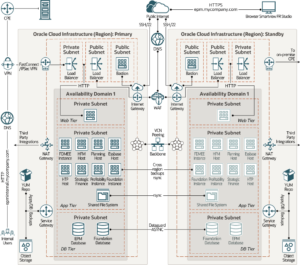
The web tier, application tier and database tier in a Region is designated as an Active or Primary site & the same services in the other Region is designated as Standby site.
In the event of failure in the Primary region, You can recover the application in the Standby region using RSYNC utility and use the global DNS resolver to redirect the External users.
Use the same logical hostnames for database and application tiers to reduce the effort of reconfiguring the instances during the failover and switch back.
All applications and database tier components are attached to the private subnet to isolate them from unauthorized network access.
To replicate the data stored in the block volumes attached to the application instances, you can take backups of the volumes, copy the backups to the remote region, and then use those backups to restore the volumes in the remote region.
Application tier components have access to the Shared File Storage for binaries and data generated by Hyperion applications. You can use RSYNC to synchronize data from Primary AD to Standby AD.
Database Tier contains Primary – Standby model databases for application management.
Hope you find this article helpful!
